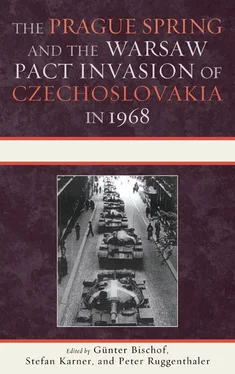Differences in the assessment of the situation in the ČSSR and of the extent of a potential interference in its internal affairs were to be observed not only in the higher reaches of the political hierarchy. The Pravda correspondent Aleksei Lukovets, who had spent the month of May in Prague, reported on serious differences of opinion within the Soviet embassy in Prague on the “crisis in the country.” Even though Ambassador Stepan Chervonenko favored, according to the journalist’s reports, an objective assessment and warned against mistakenly equating the KSČ’s line with the opinions of isolated individuals, the embassy’s minister, Udal’tsov, insisted that the only proper course to take was rigorously to criticize all developments in the country, including the line taken by the leadership of the CC KSČ and continued to dispatch notably negative reports to Moscow. 19It was obvious that Udal’tsov’s course was in alignment with that of the Kremlin hardliners. It must, however, be borne in mind that the information issuing from the embassy nevertheless contributed, whether by design or otherwise, to the assessment the Soviet leadership formed of the Czechoslovak crisis.
The Kremlin’s frantic search for solutions to the “Czechoslovak problem” and the ambivalent positions of the Soviet leaders with regard to this issue become apparent from the genesis of another Politburo resolution. This resolution concerns the preparation of an information communiqué for Communist Party leaders in a number of Eastern European countries on the results of Kosygin’s visit to Karlovy Vary. The original draft was again subjected to several rather drastic revisions (not all of which were subsequently incorporated into the final text). The contradictory nature of those that were incorporated imparts an air of incompleteness and ambivalence to the final result.
Among the proposals was the inclusion of several lengthy passages (the so-called expanded version of the missive), which contained a more detailed description of the situation in the ČSSR and in the KSČ leadership and was designed to illustrate the salient points of the developments by means of concrete examples. 20One of the sponsors of this variant was the Chairman of the Supreme Soviet of the USSR, Nikolai Podgornyi, who had been Shelest’s predecessor as party leader of Ukraine. The following points of his variants are particularly noteworthy, even though they were not included in the final document. First, more emphasis was put on the understanding Dubček and the other Czechoslovak leaders showed for the situation that had developed in the ČSSR. Secondly, it repeated the urgent request voiced by leading figures in the KSČ and addressed to the CPSU and the other fraternal parties “not to take any steps that might speculatively be exploited by the enemies of socialism to undermine the authority of the present KSČ leadership and of the ČSSR and that might give comfort within Czechoslovakia to tendencies hostile to fraternal countries and parties.” 21All this was left out in the final version of the document.
In what was arguably a first, doubts were expressed openly in the resolution as to the capability of the KSČ leadership and of the ČSSR “to rally the healthy forces around them, take the initiative into their own hands and strike back at the intrigues of the counterrevolution.” 22The final version of the document, which was ultimately dispatched to the leaders of those countries that were soon to participate in the invasion, referred to the fact that it was impossible to say with certainty whether the ČSSR leadership was capable, if the need arose, to take “decisive action, including the use of force, for instance, by workers’ militias.” 23Yet in the preparatory stage of the document, part of the Politburo successfully advocated the inclusion of an additional formulation of proposals to assist the KSČ and the ČSSR that would readily be understood by everyone, including “an alternative type of help that might become necessary if events take a negative turn.” 24
Evident from the documents are the shifts in the Soviet leaders’ position regarding the possibilities and capabilities of the so-called healthy forces in the Czechoslovak leadership to keep the situation under control. At the beginning of 1968, the KSČ leadership is perceived in the Soviet documents as a monolithic force engaged in the struggle against the class enemy’s “hostile” and “antisocialist” intrigues. In a next stage, particularly after the mass dismissal of party leaders of the old guard, which was implemented under the motto of “new politics with new people,” a terminology is promptly at hand in the Kremlin for the groups to which the Czechoslovak leaders are supposed to belong: “the rightists,” “the indecisive,” and “the healthy forces.” Even Dubček was counted among the “indecisive” more and more often, even if it was impossible for the USSR to discount his enormous popularity in the party and in the country. This was also the reason why there was little else that could be done in the existing situation than regularly and insistently to tell Dubček to be guided by the judgment of the “healthy forces” within the KSČ leadership, to rely on them, and so forth. It was noted in Moscow with growing unease that these “healthy forces” were getting steadily fewer and weaker. One of the alterations that Brezhnev undertook in the above-mentioned resolution “On the Results of Kosygin’s Visit to the ČSSR” may look insignificant at first sight, yet it is, in fact, extremely telling in this context. In the sentence “The majority of the KSČ and the ČSSR leaders make noticeable efforts to consolidate the healthy forces around them,” the general secretary substituted the phrase “part of” for “the majority.” 25The resolution was passed with this alteration. It is obvious that the Soviet head of state was motivated in this by the information he had received from Czechoslovakia (and above all by what Kosygin’s visit had netted). This amounted to a virtual acceptance of the fact that the “healthy forces” in the Czechoslovak leadership were no longer in the majority and had, in fact, lost control of the situation.
That the situation in the ČSSR dominated Soviet foreign policy in the summer of 1968 can be inferred from the steadily growing number of CC decisions and resolutions revolving around the Czechoslovak problem. From May onward, issues related to Czechoslovakia were on the agenda of Politburo sessions at least once a week and sometimes more often. During the same period, a special commission was called into being by a Politburo decision and charged with the task “of dealing with questions concerning Czechoslovakia in an operative manner and to submit, when called upon to do so, their proposals in the CC CPSU.” 26The amount of information reaching the CC from a number of different organizations and from Soviet individuals who were either permanently residing in the ČSSR or visited the country in an official capacity (delegations of party officials, representatives of twin towns, scientists, artists, and so forth) rose steadily.
As regards the analysis of decisions and resolutions on Czechoslovakia that were hammered out and adopted in Politburo sessions, it is necessary to underscore several characteristic peculiarities. There was above all the tendency to adopt a more cautious and moderate attitude in assessing the situation. CC documents dating from spring 1968 mostly tended to assume a more demanding, threatening tone in the final version compared to their original draft. At times, one gets the impression that Moscow was ready every day to use military force. The beginning of summer saw a complete reversal of this situation. Much confrontational language was either deleted from the drafts altogether or at least toned down. This was all the more remarkable because the situation in the ČSSR deteriorated steadily in the eyes of the leading Soviet figures themselves! This can be explained, in part, by Moscow worrying it was exposing itself to charges of exerting “excessive pressure” on Prague. In addition to this, the Soviet leadership, which was well aware of the complexity of the situation, was still trying to get Dubček to “re-establish order in the country of his own free will,” as he had already repeatedly promised.
Читать дальше












